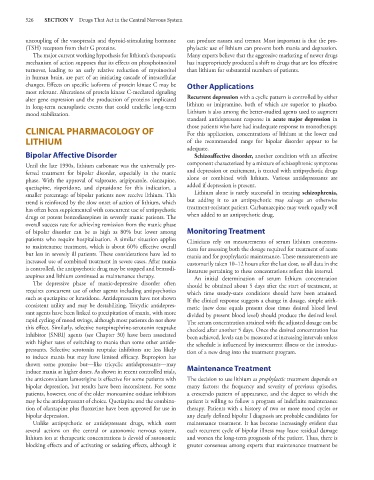Page 540 - Basic _ Clinical Pharmacology ( PDFDrive )
P. 540
526 SECTION V Drugs That Act in the Central Nervous System
uncoupling of the vasopressin and thyroid-stimulating hormone can produce nausea and tremor. Most important is that the pro-
(TSH) receptors from their G proteins. phylactic use of lithium can prevent both mania and depression.
The major current working hypothesis for lithium’s therapeutic Many experts believe that the aggressive marketing of newer drugs
mechanism of action supposes that its effects on phosphoinositol has inappropriately produced a shift to drugs that are less effective
turnover, leading to an early relative reduction of myoinositol than lithium for substantial numbers of patients.
in human brain, are part of an initiating cascade of intracellular
changes. Effects on specific isoforms of protein kinase C may be Other Applications
most relevant. Alterations of protein kinase C-mediated signaling
alter gene expression and the production of proteins implicated Recurrent depression with a cyclic pattern is controlled by either
in long-term neuroplastic events that could underlie long-term lithium or imipramine, both of which are superior to placebo.
mood stabilization. Lithium is also among the better-studied agents used to augment
standard antidepressant response in acute major depression in
CLINICAL PHARMACOLOGY OF those patients who have had inadequate response to monotherapy.
For this application, concentrations of lithium at the lower end
LITHIUM of the recommended range for bipolar disorder appear to be
adequate.
Bipolar Affective Disorder Schizoaffective disorder, another condition with an affective
Until the late 1990s, lithium carbonate was the universally pre- component characterized by a mixture of schizophrenic symptoms
ferred treatment for bipolar disorder, especially in the manic and depression or excitement, is treated with antipsychotic drugs
phase. With the approval of valproate, aripiprazole, olanzapine, alone or combined with lithium. Various antidepressants are
quetiapine, risperidone, and ziprasidone for this indication, a added if depression is present.
smaller percentage of bipolar patients now receive lithium. This Lithium alone is rarely successful in treating schizophrenia,
trend is reinforced by the slow onset of action of lithium, which but adding it to an antipsychotic may salvage an otherwise
has often been supplemented with concurrent use of antipsychotic treatment-resistant patient. Carbamazepine may work equally well
drugs or potent benzodiazepines in severely manic patients. The when added to an antipsychotic drug.
overall success rate for achieving remission from the manic phase
of bipolar disorder can be as high as 80% but lower among Monitoring Treatment
patients who require hospitalization. A similar situation applies Clinicians rely on measurements of serum lithium concentra-
to maintenance treatment, which is about 60% effective overall tions for assessing both the dosage required for treatment of acute
but less in severely ill patients. These considerations have led to mania and for prophylactic maintenance. These measurements are
increased use of combined treatment in severe cases. After mania customarily taken 10–12 hours after the last dose, so all data in the
is controlled, the antipsychotic drug may be stopped and benzodi- literature pertaining to these concentrations reflect this interval.
azepines and lithium continued as maintenance therapy. An initial determination of serum lithium concentration
The depressive phase of manic-depressive disorder often should be obtained about 5 days after the start of treatment, at
requires concurrent use of other agents including antipsychotics which time steady-state conditions should have been attained.
such as quetiapine or lurasidone. Antidepressants have not shown If the clinical response suggests a change in dosage, simple arith-
consistent utility and may be destabilizing. Tricyclic antidepres- metic (new dose equals present dose times desired blood level
sant agents have been linked to precipitation of mania, with more divided by present blood level) should produce the desired level.
rapid cycling of mood swings, although most patients do not show The serum concentration attained with the adjusted dosage can be
this effect. Similarly, selective norepinephrine-serotonin reuptake checked after another 5 days. Once the desired concentration has
inhibitor (SNRI) agents (see Chapter 30) have been associated been achieved, levels can be measured at increasing intervals unless
with higher rates of switching to mania than some other antide- the schedule is influenced by intercurrent illness or the introduc-
pressants. Selective serotonin reuptake inhibitors are less likely tion of a new drug into the treatment program.
to induce mania but may have limited efficacy. Bupropion has
shown some promise but—like tricyclic antidepressants—may Maintenance Treatment
induce mania at higher doses. As shown in recent controlled trials,
the anticonvulsant lamotrigine is effective for some patients with The decision to use lithium as prophylactic treatment depends on
bipolar depression, but results have been inconsistent. For some many factors: the frequency and severity of previous episodes,
patients, however, one of the older monoamine oxidase inhibitors a crescendo pattern of appearance, and the degree to which the
may be the antidepressant of choice. Quetiapine and the combina- patient is willing to follow a program of indefinite maintenance
tion of olanzapine plus fluoxetine have been approved for use in therapy. Patients with a history of two or more mood cycles or
bipolar depression. any clearly defined bipolar I diagnosis are probable candidates for
Unlike antipsychotic or antidepressant drugs, which exert maintenance treatment. It has become increasingly evident that
several actions on the central or autonomic nervous system, each recurrent cycle of bipolar illness may leave residual damage
lithium ion at therapeutic concentrations is devoid of autonomic and worsen the long-term prognosis of the patient. Thus, there is
blocking effects and of activating or sedating effects, although it greater consensus among experts that maintenance treatment be

